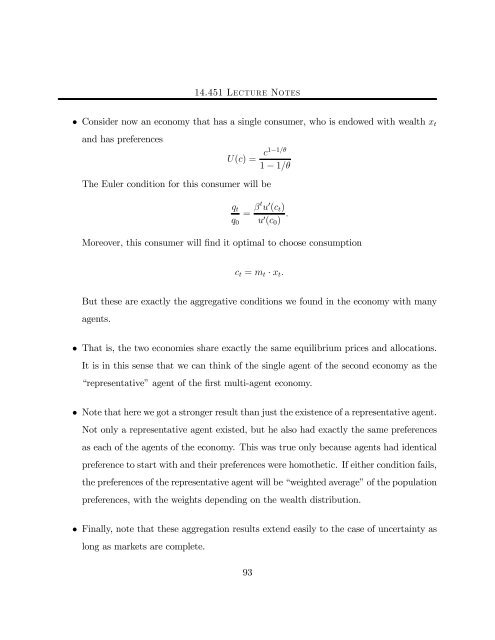14.451 Lecture Notes Economic Growth
14.451 Lecture Notes Economic Growth
14.451 Lecture Notes Economic Growth
Create successful ePaper yourself
Turn your PDF publications into a flip-book with our unique Google optimized e-Paper software.
<strong>14.451</strong> <strong>Lecture</strong> <strong>Notes</strong><br />
• Consider now an economy that has a single consumer, who is endowed with wealth xt<br />
and has preferences<br />
U(c) = c1−1/θ<br />
1 − 1/θ<br />
The Euler condition for this consumer will be<br />
qt<br />
q0<br />
= βt u 0 (ct)<br />
u 0 (c0) .<br />
Moreover, this consumer will find it optimal to choose consumption<br />
ct = mt · xt.<br />
But these are exactly the aggregative conditions we found in the economy with many<br />
agents.<br />
• That is, the two economies share exactly the same equilibrium prices and allocations.<br />
It is in this sense that we can think of the single agent of the second economy as the<br />
“representative” agent of the first multi-agent economy.<br />
• Note that here we got a stronger result than just the existence of a representative agent.<br />
Not only a representative agent existed, but he also had exactly the same preferences<br />
as each of the agents of the economy. This was true only because agents had identical<br />
preference to start with and their preferences were homothetic. If either condition fails,<br />
the preferences of the representative agent will be “weighted average” of the population<br />
preferences, with the weights depending on the wealth distribution.<br />
• Finally, note that these aggregation results extend easily to the case of uncertainty as<br />
long as markets are complete.<br />
93

















